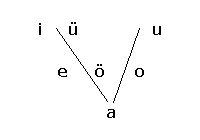Vowel triangle
The vowel triangle is a graphic arrangement of human vowels according to their point of articulation (tongue curvature or degree of opening), especially the monophthongs . The first representation of the vowel triangle goes back to the doctoral thesis of the German doctor Christoph Friedrich Hellwag (1754–1835) published in 1781 :
Representation of the tongue position
The base of the triangle is formed by the (as far as the tongue position is concerned) "low" vowel a; the tips form the “high” vowels i or ü (with rounded lips) at the front articulation point and the “high” vowel u at the back articulation point. E or ö (with rounded lips) at the anterior articulation point and o at the rear articulation point have a medium degree of opening.
There is also another representation, which shows the indication of the respective mouth opening and which is sometimes called the vowel trapezoid .
Representation of the first two formants
From an acoustic point of view, the vowel triangle is better described by the formants of the vowels . These are resonances of certain overtones that play a special role in sound engineering for the sounds of musical instruments and voices, because they have a decisive influence on the color of the sound and contribute to recognizability. Erich Schumann became known through his sound color laws (1929) .
In the Sound Design ( Sound Design ) a vowel diagram is represented by the axes of the graph, the first two formant frequencies f 1 and f 2 are registered. When processing the sound of a recording studio, the inner imagination and memory of the vocal color of the respective vowel and the knowledge of the location of its mid-frequencies are advantageous, whereby the formants of important musical instruments that shape the sound are also very helpful in the imagination.
literature
- Michael Dickreiter, Volker Dittel, Wolfgang Hoeg, Martin Wöhr (eds.), Handbuch der Tonstudiotechnik , 8th revised and expanded edition, 2 volumes, publisher: Walter de Gruyter, Berlin / Boston, 2014, ISBN 978-3-11-028978 -7 or e- ISBN 978-3-11-031650-6 .
Web links
- Vowel triangle - frequency position of the first two formants (schematic) (PDF file; 230 kB)
